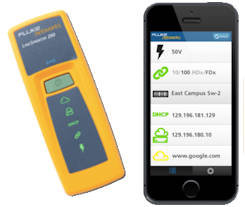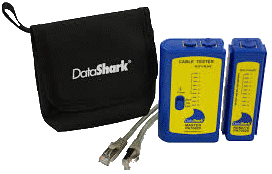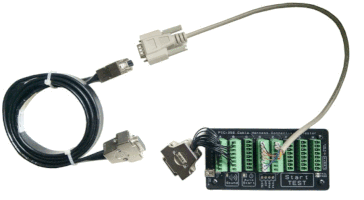A quick wiring reference guide to the network cable using RS45 connector (or the 8P8C modular plug).
Pinout
The following is the most common wiring color scheme (T568B) for Ethernet network cable.
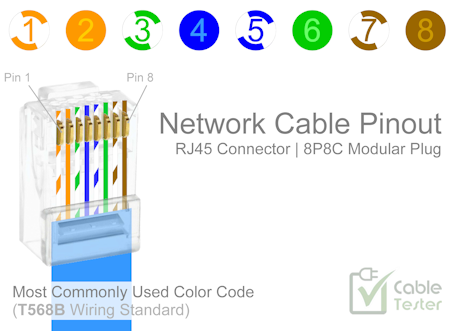
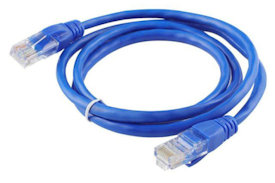
T568A vs T568B … What is the difference?
T568B wiring color code scheme is the most commonly used standard. The difference between T568B and T568A is in the color code scheme. Orange color twisted pair is swap with the green pair. If you are doing a Straight Cable for your network connection, it doesn’t make any difference using T568B or T568A color code scheme.
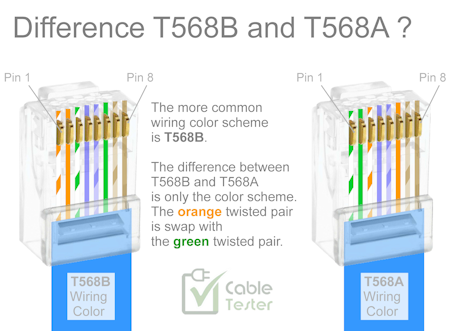
Reference: https://www.truecable.com/blogs/cable-academy/t568a-vs-t568b#
Why is it important to follow the wiring color scheme?
It is important to follow the color scheme as it will have impact on the data communication speed. TX+ TX- pair and RX+ RX- pair has to be in the same twisted wired pair.
The data communication is using differential signal transmission method. Differential signalling travels further down the line and can support higher data transmission speed. It is important to twist this pair of wires throughout the transmission line, as twisted pair wire have minimum gap between the wire. Gap allow interference from nearby surrounding noise, or adjacent signal wires. This interference result in signal/data corruption and hence a low data throughput rate across the cable. It you do not wire the TX and RX wire in twisted pairs, you will observe a significant drop in your network speed to as low as 10Mbps or lesser. If you are interested to learn more about this topic, you can study books relating to electromagnetic wave, radio frequency transmission theory.
In the T568B wiring scheme, TX+ TX- are the orange/white orange wire pairs, and RX+ RX- are the green/white green wire pairs.
Crossover Network Cable
The crossover cable means that on one end of the cable is using the T568B wiring color scheme, while the other end uses T568A. This means that the TX signal transmit from one end is connected to the RX on the receiver end.
Cross network cable is seldom needed these days. They are use when a computer need a direct communication connection to another computer system, instead of to the hub. Most of the network interface circuitry is able to do automatic line switching internally. This is why we normally only deal with straight network cable these days. There is no longer a need to be concern with whether to use a cross cable or a straight cable.
Straight network cable has the same wiring color scheme on both end of the cable. It can be both cable end with T568B color code, or both end using T568A color code.
Reference: https://www.practicalnetworking.net/stand-alone/ethernet-wiring/#why_crossover
Ethernet Pinout Signal
The following table is the physical signal of the RJ45 pinout from a computer system (from PC side). Pin 1 and 2 are transmitting data out from the computer to a Hub.
| RJ45 Plug Pin no. | T568B color scheme | 10/100 BASE-T | 1000BASE-T |
| 1 |  orange/white orange/white | TX+ | DA+ |
| 2 |  orange orange | TX- | DA- |
| 3 |  green/white green/white | RX+ | DB+ |
| 4 |  blue blue | not used | DC- |
| 5 |  blue/white blue/white | not used | DC+ |
| 6 |  green green | RX- | DB- |
| 7 |  brown/white brown/white | not used | DD+ |
| 8 |  brown brown | not used | DD- |
Reference: https://en.wikipedia.org/wiki/ANSI/TIA-568
Data flow between PC and Hub
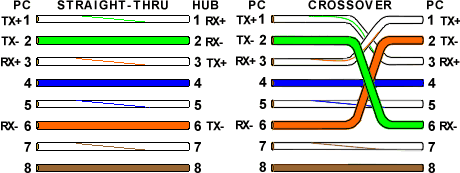
The data flow connection between a PC and a Hub is crossed internally at their RJ45 socket pin connection. A straight network cable is used for connecting between these 2 devices.
When a PC needs to be connected to a PC, or a Hub to another Hub, a cross cable is required to ensure that the data is transmitted on one end, while the other end of the PC gets to receive the data.
Cross cable is seldom needed these days as the Ethernet hardware today can automatic switch the TX RX internally within the hardware level. User does not need to be concern with using a cross or straight network cable.
Reference: https://incentre.net/ethernet-cable-color-coding-diagram/
Legend (CAT network cable)
Pair 1 – Blue + Blue/White
Pair 2 – Orange + Orange/White
Pair 3 – Green + Green/White
Pair 4 – Brown + Brown/White
Tool to make your work easier
8P8C Plug
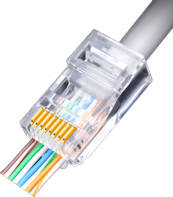
This is a new type of RJ45 modular plug that allows wire through the tip of the plug. This RJ45 plug design makes it much easier to insert the wire. There is no need to trim the 8x wires to proper length first before inserting them into the RJ45 plug for crimping.
These new type of RJ45 plug connector is also made of more elastic material. The quick release lever catch is more flexible and does not break so easily.
You will need the following crimping tool to crimp and trim the wires in a single clamp action.
Crimping Tool
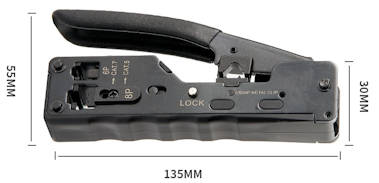
This is a small portable and handy crimping tool for RJ45 connector. It can crimp 8P8C modular plug, as well as trimming the network CAT wires all in a single action.
Network Access Tester
This network access tester helps to test the network connectivity of your physical network point directly with your mobile phone. Quick and portable tool to check for network connectivity on site.
Network Cable Tester
This is a simple network cable tester. Checks if the network cable is probably crimped, or if they are still usable.
Click here for more information on this Network Cable Tester.

